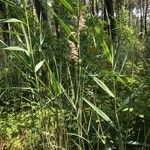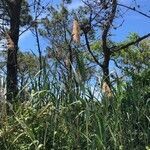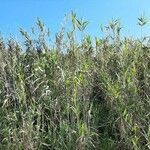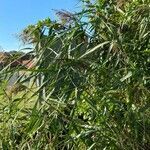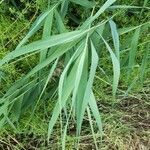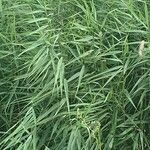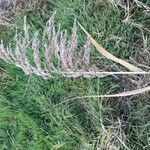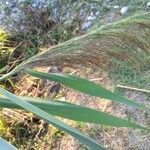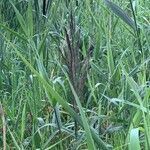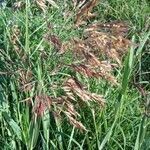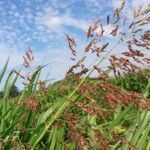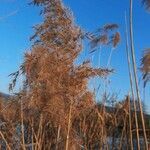Robust perennial from an extensive creeping rhizome; overground stolons sometimes present, straight, nodes glabrous. Culms up to 2 m or more tall, ca. 6 mm in diam., usually farinose below nodes, nodes glabrous or pubescent. Leaf sheaths light green, glabrous or thinly hairy; leaf blades usually drooping, up to 50 × 1–3 cm, smooth or margins scabrous, tapering to a filiform apex; ligule a minute membranous rim, ciliate, hairs 0.2–0.6 mm. Panicle 20–50 × ca. 10 cm, branches of lowermost whorl usually spiculate to base, densely hirsute at insertion; pedicels 2–4 mm, glabrous or pilose only at base. Spikelets 10–18 mm, florets 2–5; glumes acute, lower glume up to 1/2 length of lowest lemma, 3–5 mm, upper glume 6–9 mm; lowest lemma linear-lanceolate, 8–15 mm; floret callus with hairs equal to lemma; bisexual lemmas very narrowly lanceolate, 9–16 mm, apex long attenuate. Fl. and fr. Jul–Nov. 2n = 36, 44, 46, 48, 49, 50, 51, 52, 54, 84, 96, 120.
Robust, perennial reed, up to 4 m high; rhizomes long; culms solitary, not tillering; leaves cauline, deciduous at base of blade, thus sheath remains on culm. Leaf blade 350 x 35 mm, apex filiform and flexuous; ligule a fringed membrane or a fringe of hairs. Inflorescence a large, 120-400 mm long, compact, drooping, densely plumose panicle, with a ring of silky hairs at base of lowest branches; spikelets solitary, pedicelled. Spikelets 10-18 mm long, laterally compressed; glumes very unequal, shorter than spikelet; upper glume 6-9 mm long, acute. Florets 3-11; lowermost floret male or sterile; succeeding florets bisexual; lemma entire, glabrous, acuminate or tapering into an awn; awn straight, shorter than body of lemma; callus with silky hairs 6-10 mm long; anther 1.5-2.0 mm long. Flowering time Dec.-June.
A thick stemmed grass. It keeps growing from year to year from underground creeping stems or rhizomes. The stalks are erect. The stems are about 3 m high and 1 cm across. They have many nodes and are hollow in between these. The leaves are produced all the way up the stem. The leaves are 80 cm long by 4 cm wide. The leaves sheath the base. The blade is flat or slightly rolled inwards. The leaves are smooth underneath. The leaves point upwards and curve over. The flower panicle is about 40 cm long. It is green with purple tones and becomes creamy-white. The spikelets are 1-1.8 cm long.
Perennial; up to 0.6-4.0 m high; long-rhizomatous. Culms robust; solitary; not tillering; leaves deciduous at base of blade; sheath persistent on culm. Leaf blades up to 35 x 35 mm; tapering into a long filiform and flexible apex; leaves cauline; ligule with fringing hairs equalling or longer than membranous base. Flowers: panicle compact; 120-400 mm long; spikelets 10-18 mm long; upper glume 6-9 mm long; lemmas glabrous; callus hairs 6-10 mm long.
Culms 1–3 m high. Leaf blades 20–60 cm long, 8–50 mm wide. Inflorescences with 200–500 spikelets. Spikelets 10–18 mm long, with 3–7 florets. Glumes shorter than spikelet, straw-coloured; lower glume 3–7 mm long; upper glume 6–10 mm long. Callus indumentum tufted, 8–14 mm long. Lemma 9–13 mm long, awnless, glabrous. Palea elliptic to ovate, 3–4 mm long, glabrous between keels. Anthers 1–2 mm long. Caryopsis 1.4 mm long.
Robust perennial, up to 4 m high; rhizomes long; culms solitary, not tillering; leaves cauline, deciduous at base of blade, sheath persistent on culm. Leaf blade 350 x 35 mm, apex filiform, flexuous. Inflorescence compact, 120-400 mm long; with a ring of silky hairs at base of lowest branches. Spikelet 10-18 mm long; upper glume 6-9 mm long, acute; lemma glabrous; callus hairs 6-10 mm long; anther 1.5-2.0 mm long.
Robust, reed-like perennial, up to 4 m tall. Ligule a fringe of hairs (unlike Arundo donax with a fringed membranous ligule). Leaves cauline, lanceolate, deciduous at base of blade. Inflorescence a plumose panicle, brown and white, 300-500 mm long, branches dropping at maturity. Spikelets 10-18 mm long; awned or awnless, long-acuminate, many-flowered; rhachilla hairs 5-10 mm long; lemma glabrous.
Perennial, long-rhizomatous, up to 0.6-4.0 m high. Leaf blades up to 35 mm long, up to 35 mm wide, leaves cauline, deciduous at base of blade; with a long tapering ligule with fringing hairs; hairs equalling or longer than membranous base. Culms robust, solitary, not tillering. Spikelets 10-18 mm long. Inflorescences compact, 120-400 mm long; upper glume 5-9 mm long. Lemmas glabrous.
Robust, reed-like perennial to 3 m. Leaves cauline, lanceolate. Spikelets in a plumose panicle, brown and white, awned.
